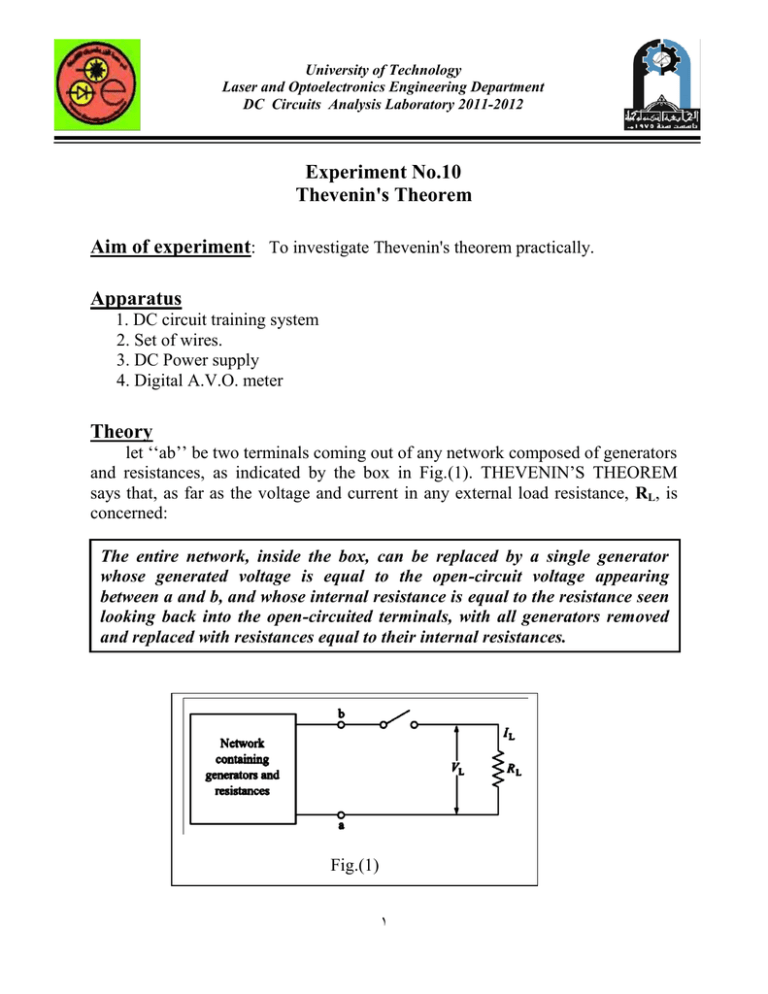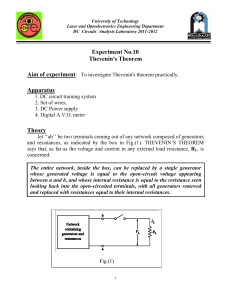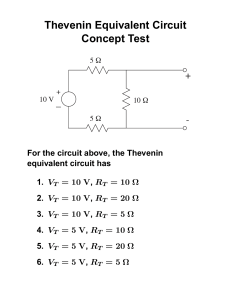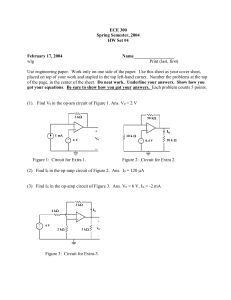Experiment No.10 Thevenin`s Theorem Apparatus Theory
advertisement

University of Technology Laser and Optoelectronics Engineering Department DC Circuits Analysis Laboratory 2011-2012 Experiment No.10 Thevenin's Theorem Aim of experiment: To investigate Thevenin's theorem practically. Apparatus 1. DC circuit training system 2. Set of wires. 3. DC Power supply 4. Digital A.V.O. meter Theory let ‘‘ab’’ be two terminals coming out of any network composed of generators and resistances, as indicated by the box in Fig.(1). THEVENIN’S THEOREM says that, as far as the voltage and current in any external load resistance, RL, is concerned: The entire network, inside the box, can be replaced by a single generator whose generated voltage is equal to the open-circuit voltage appearing between a and b, and whose internal resistance is equal to the resistance seen looking back into the open-circuited terminals, with all generators removed and replaced with resistances equal to their internal resistances. Fig.(1) 1 University of Technology Laser and Optoelectronics Engineering Department DC Circuits Analysis Laboratory 2011-2012 Procedural Steps for finding Thevenin's Equivalent Circuit Remove the resistance (called load resistance RL) whose current is required. Find the open-circuit voltage Voc that appears across the two terminals from where resistance has removed. It also called Thevenin voltage Vth. Compute the resistance of the whole network as looked into from these two terminals after all sources of e.m.f. have removed. It also called Thevenin resistance Rth. Replace the entire network by single Thevenin source whose voltage is Vth or Voc and whose internal resistance is Ri or Rth. Connect RL back to its terminals where it previously removed. Finally, calculate the current flowing through RL by using the equation, I = Vth / ( Rth + RL ) or R1 A E R2 v Ri I = Voc /( Ri + RL ) A Ri RL RL v B B Procedure 1. Using the DC circuit trainer, connect the circuit shown below. 2. Measure the current and voltage of RL and record it. A B A 82 100 V 30 - 5V 50 + RL 2 330 University of Technology Laser and Optoelectronics Engineering Department DC Circuits Analysis Laboratory 2011-2012 3. Remove (RL) and measure (Vth) or (VAB) as shown below A 82 B Vth V 30 - 50 + 5V 330 4. Replace voltage source by short cct , then measure (Rth) or (RAB) A B 82 Rth 30 50 3 330 University of Technology Laser and Optoelectronics Engineering Department DC Circuits Analysis Laboratory 2011-2012 5. Using the DC circuit trainer, connect the circuit shown in figure below (Thevenin's equivalent circuit) according to the results from step (3) & (4) and then measure (IL &VL). Rth RL Vth Thevenin s equivalent cct 6. Repeat the steps (2 to 5 ) by using RL = (30,330,50,82) Discussion and calculation 1. Compare between the practical and Theoretical results. 2. Comment on the results 3. Find Thevenin's equivalent circuit for the circuit shown below 4





